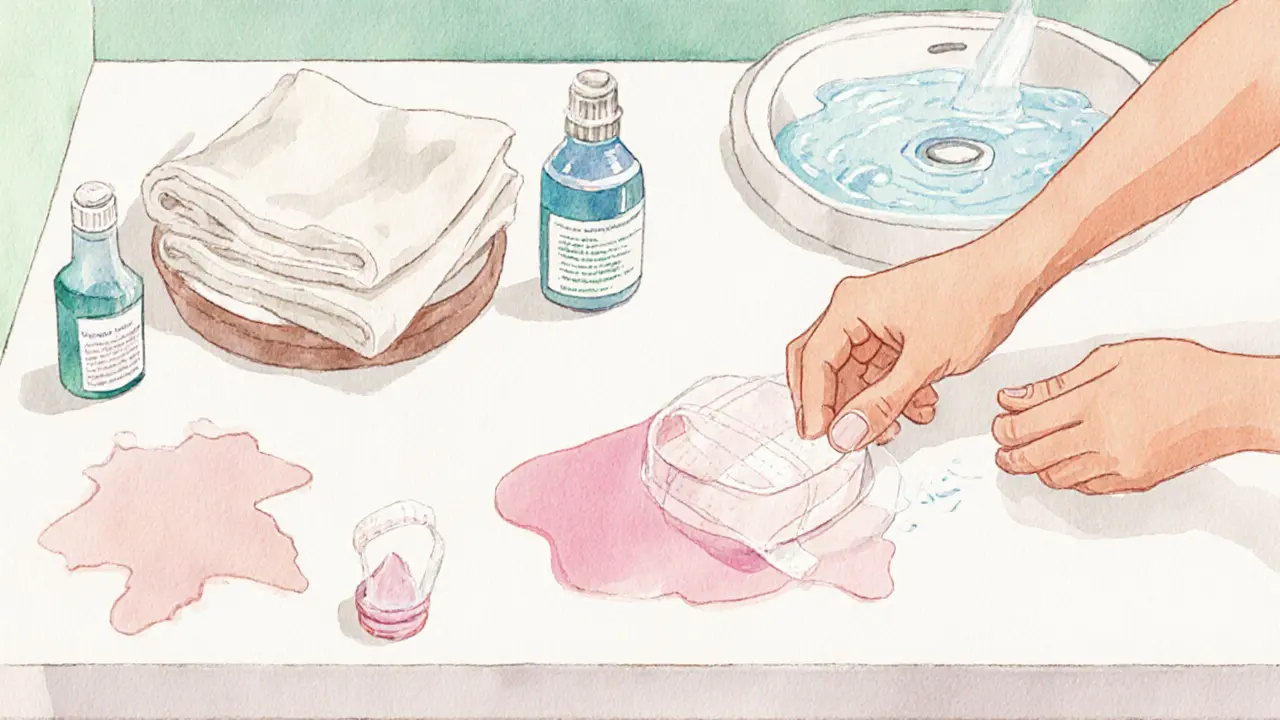When discussing oral sex without condom is a sexual activity where the mouth contacts a partner’s genitals or anus without using a barrier like a condom, many people wonder about the health implications. This guide breaks down the science, the real‑world risks, and practical steps you can take to stay safe while still enjoying intimacy.
Understanding the Basics of Oral Sex Without a Condom
Origins and History
Oral sexual practices have been documented across cultures for centuries, from ancient Roman texts to traditional Asian rites. Historically, the focus was on pleasure rather than disease prevention because knowledge of pathogens was limited.
Core Principles or Components
At its core, oral sex without a condom involves direct mucous‑membrane contact. The mouth, throat, and saliva interact with genital or anal tissues, creating pathways for viruses, bacteria, and parasites to move between bodies.
How It Differs from Related Practices
Compared to vaginal or anal intercourse with a condom, unprotected oral sex eliminates a physical barrier but still offers a lower overall transmission probability for many STIs. The difference lies in the type of tissue exposed and the amount of bodily fluid exchanged.
| Practice | STI Risk Level | Protection Level | Sensation |
|---|---|---|---|
| Oral sex with condom | Low | High | Reduced |
| Oral sex without condom | Moderate | None | Full |
Who Can Benefit from Knowing the Risks?
Anyone who engages in oral intimacy-whether in a committed relationship, casual encounter, or experimental setting-should understand the potential health outcomes. Knowledge helps individuals make informed choices, negotiate safer practices, and seek timely medical advice if needed.
Benefits of Oral Sex for Body and Relationship
Intimacy and Emotional Connection
Beyond the physical act, oral sex can deepen trust and closeness. When both partners feel heard and respected, the experience often boosts relationship satisfaction.
Pleasurable Sensation
The mouth’s nerve endings are highly sensitive, offering intense pleasure that many people find unique compared to other sexual acts.
Low‑Impact Physical Activity
Unlike vigorous intercourse, oral sex is gentle on joints and muscles, making it a comfortable option for people with mobility concerns.
Practical Applications
When used as part of a varied sexual repertoire, oral sex can alleviate sexual boredom and keep the connection fresh. Below is a quick snapshot of its key advantages.
| Benefit | Description | Potential Impact |
|---|---|---|
| Intimacy boost | Strengthens emotional bond | Higher relationship satisfaction |
| Enhanced pleasure | Direct stimulation of sensitive tissue | Increased sexual enjoyment |
| Low physical strain | Gentle on body | Accessible for varied fitness levels |
| Versatility | Can be combined with other acts | Prevents routine fatigue |
What to Expect When Engaging in Oral Sex Without a Condom
Setting or Context
A private, relaxed environment helps both partners feel comfortable. Good lighting, clean surfaces, and a calm mood reduce anxiety and improve focus on pleasure.
Key Processes or Steps
- Discuss boundaries and any STI testing history.
- Wash hands and consider a quick oral rinse.
- Begin with gentle kisses, gauge comfort.
- Proceed to stimulation, varying pressure and speed.
- Monitor for any signs of discomfort or irritation.
Customization Options
Some people prefer using flavored lubricants or flavored non‑latex barriers that still feel close to skin. Others may incorporate teeth‑free techniques, tongue play, or hand assistance to vary sensation.
Communication and Preparation
Clear consent is non‑negotiable. Simple phrases like “Is this okay?” or “Let me know if it’s too much” keep the experience safe and enjoyable.

How to Practice Oral Sex Safely Without a Condom
Setting Up for Success
Start with a clean space: wipe surfaces with an antibacterial wipe, ensure fresh towels, and have water nearby for rinsing. Good lighting helps you see any potential cuts or sores that could increase risk.
Choosing the Right Tools and Resources
While the act itself doesn’t need equipment, a few items can boost safety:
- Dental dam - a thin latex or polyurethane sheet that acts as a barrier for oral‑genital contact.
- Non‑oil‑based lubricant to avoid condom degradation if you later decide to add one.
- Antibacterial mouthwash for after‑care.
Step‑by‑Step Guide
- Both partners share recent STI test results; discuss any known infections.
- Perform a quick visual check for cuts, cold sores, or genital lesions.
- Wash hands thoroughly with soap for at least 20 seconds.
- If using a dental dam, place it over the genital area, ensuring no air bubbles.
- Engage with slow, attentive movements; pay attention to partner feedback.
- Afterward, rinse mouth with water or a mild mouthwash, and wash any used barriers.
Tips for Beginners or Couples
Start slow and focus on pleasure, not performance. Experiment with different angles or using hands simultaneously. If a partner has a recent cold sore, avoid contact until it heals to prevent herpes transmission.
FAQ: Common Questions About Oral Sex Without a Condom
Can you get an STI from oral sex without a condom?
Yes. Viruses such as herpes simplex (HSV‑1, HSV‑2), human papillomavirus (HPV), and HIV can be transmitted through oral‑genital or oral‑anal contact, especially if there are cuts, sores, or active lesions. Bacterial infections like gonorrhea and chlamydia also have oral transmission routes.
Which STIs are most likely to spread this way?
Herpes simplex and HPV are the most common because they thrive in the moist environment of the mouth and throat. HIV transmission is possible but statistically lower; the risk rises if there are bleeding gums or open sores.
How does using a dental dam compare to a condom?
A dental dam works similarly to a condom for oral‑genital contact. It blocks fluid exchange while still allowing sensation. Some people find it less natural feeling, but it dramatically cuts transmission risk for most STIs.
What should I do if I notice symptoms after oral sex?
Seek medical evaluation promptly. Early testing for STIs can catch infections before they spread. Keep the area clean, avoid further oral contact, and discuss any concerns with your healthcare provider.
Is it safe to combine oral sex with other sexual activities in one session?
Yes, as long as you maintain hygiene between acts. Switching from oral to vaginal or anal sex without changing condoms or cleaning can increase cross‑contamination risk. Use fresh barriers or wash hands thoroughly between activities.
Safety and Ethical Considerations
Choosing Qualified Health Resources
Look for information from reputable bodies such as the Centers for Disease Control and Prevention (CDC), World Health Organization (WHO), or national sexual health clinics. These sources provide up‑to‑date guidelines on testing and prevention.
Safety Practices
| Practice | Purpose | Example |
|---|---|---|
| Regular STI testing | Detect infections early | Quarterly blood and urine tests |
| Oral hygiene | Reduce bacterial load | Brush, floss, and use mouthwash |
| Barrier use when possible | Block fluid exchange | Dental dam or condom |
| Avoid during active lesions | Minimize transmission | Skip oral if partner has cold sore |
Setting Boundaries
Both partners should voice comfort levels. If any doubt arises, pause and revisit the conversation. Consent can be withdrawn at any moment.
Contraindications or Risks
People with weakened immune systems, recent oral surgery, or severe gum disease should avoid unprotected oral sex, as their bodies are more vulnerable to infection. Consulting a healthcare professional is advised.

Enhancing Your Experience
Adding Complementary Practices
Mindfulness breathing exercises before intimacy can heighten awareness and relax muscles, making oral stimulation feel even better.
Solo or Partnered Engagement
Exploring solo oral techniques-like using flavored oral sex toys-helps you learn what feels good, which you can then share with a partner.
Using Props
Soft silicone oral covers or flavored lubricants can add texture without compromising safety.
Regular Engagement for Benefits
Consistent, consensual oral intimacy can improve overall relationship satisfaction, boost oxytocin levels, and contribute to a healthier sexual life.
Finding Resources or Experts
Researching Qualified Professionals
Seek doctors who specialize in sexual health or certified sexual wellness counselors. Verify credentials through local medical boards or professional directories.
Online Guides and Communities
Forums like Reddit’s r/sex or reputable sexual health sites (e.g., Planned Parenthood) offer peer advice and up‑to‑date information.
Legal or Cultural Considerations
Some jurisdictions have age‑of‑consent laws that affect what is legally permissible. Cultural norms may also influence comfort levels-respect these differences.
Resources for Continued Learning
Books such as "The Guide to Safer Sex" or video series from accredited sexual health educators provide deeper insight.
Conclusion: Why Oral Sex Without a Condom Is Worth Understanding
A Path to Informed Pleasure
Knowing the risks lets you weigh pleasure against safety, choose appropriate barriers, and communicate clearly with partners.
Try It Mindfully
If you decide to engage without a condom, follow the safety steps outlined-test regularly, keep oral hygiene sharp, and consider a dental dam as a low‑impact alternative.
Share Your Journey
Have you tried any of these tips? Drop a comment below or follow the blog for more sexual‑health guidance. Some links may be affiliate links, but all recommendations are based on research and quality.

